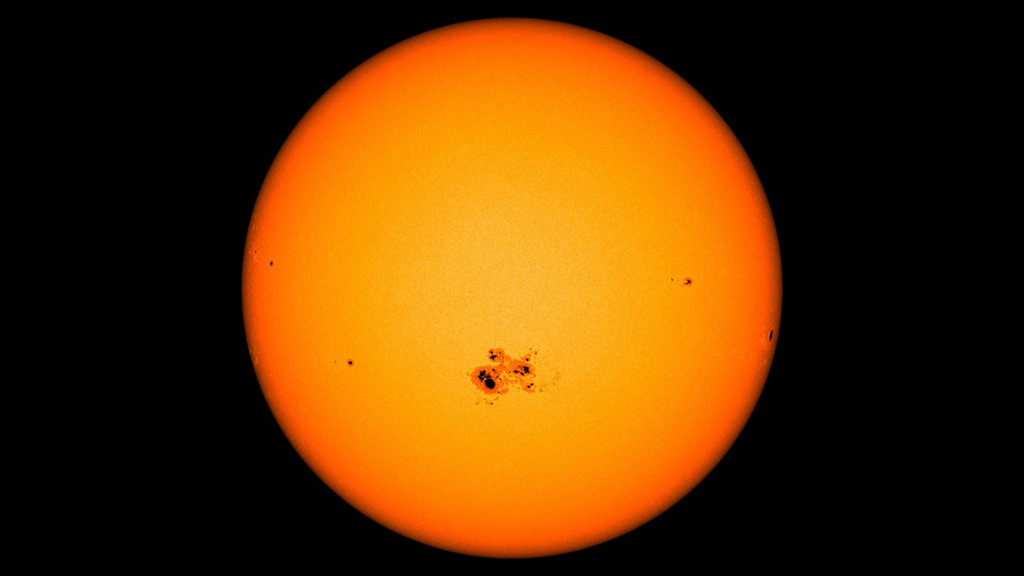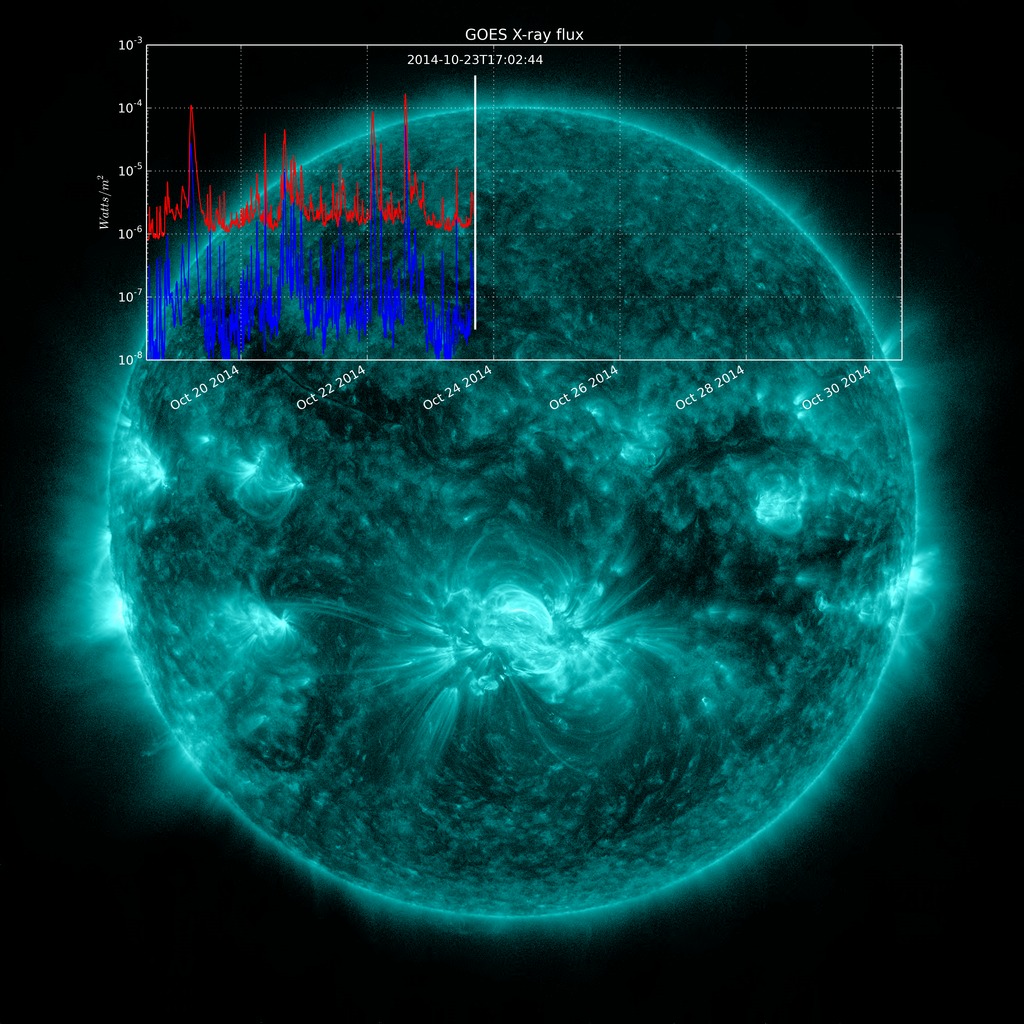Giant Sunspot Continues to Erupt with Substantial Flares
Video tracking a giant sunspot from Oct. 19 - Oct. 27, 2014. The active region released many significant flares. This video highlights 5 X-class flares.
The sun emitted a significant solar flare, peaking at 5:40 p.m. EDT on Oct. 24, 2014. NASA's Solar Dynamics Observatory, which watches the sun constantly, captured images of the event. Solar flares are powerful bursts of radiation. Harmful radiation from a flare cannot pass through Earth's atmosphere to physically affect humans on the ground, however -- when intense enough -- they can disturb the atmosphere in the layer where GPS and communications signals travel.
This flare is classified as an X3.1-class flare.
X-class denotes the most intense flares, while the number provides more information about its strength. An X2 is twice as intense as an X1, an X3 is three times as intense, etc.
The flare erupted from a particularly large active region -- labeled AR 12192 -- on the sun that is the largest in 24 years. This is the fourth substantial flare from this active region since Oct. 19.
The giant active region on the sun erupted on Oct. 26, 2014, with it's sixth substantial flare since Oct.19. This flare was classified as an X2-class flare and it peaked at 6:56 am EDT.
Continuing a week's worth of substantial flares beginning on Oct.19, 2014, the sun emitted two mid-level solar flares on Oct. 26 and Oct. 27. The first peaked at 8:34 pm EDT on Oct. 26, 2014, and the second peaked almost 10 hours later at 6:09 am EDT on Oct. 27. NASA's Solar Dynamics Observatory, which constantly observes the sun, captured images of both flares.
A large active region on the sun erupted with another X-class flare, an X2.0, on Oct. 27, 2014 -- its fourth since Oct. 24. The flare peaked at 10:47 a.m. EDT.
The sun emitted a mid-level solar flare, an M6.6-class, peaking at 11:32 pm EDT on Oct. 28, 2014

A large active region erupts with a mid-level flare, an M6.6-class, in this image from NASA's SDO on the night of Oct. 27, 2014. The region will soon rotate over the right horizon of the sun and will no longer be facing Earth. Cropped.
Image Credit:
NASA/GSFC/SDO

A large active region erupts with a mid-level flare, an M6.6-class, in this image from NASA's SDO on the night of Oct. 27, 2014. The region will soon rotate over the right horizon of the sun and will no longer be facing Earth.
Image Credit:
NASA/GSFC/SDO

Active region AR 12192 on the sun erupted with an X2.0 flare on Oct. 27, 2014, as seen in the bright light of this image captured by NASA's Solar Dynamics Observatory. This image shows extreme ultraviolet light that highlights the hot solar material in the sun's atmosphere. Cropped.
Credit: NASA/GSFC/SDO

Active region AR 12192 on the sun erupted with an X2.0 flare on Oct. 27, 2014, as seen in the bright light of this image captured by NASA's Solar Dynamics Observatory. This image shows extreme ultraviolet light that highlights the hot solar material in the sun's atmosphere. With Earth to scale.
Credit: NASA/GSFC/SDO

Active region AR 12192 on the sun erupted with an X2.0 flare on Oct. 27, 2014, as seen in the bright light of this image captured by NASA's Solar Dynamics Observatory. This image shows extreme ultraviolet light that highlights the hot solar material in the sun's atmosphere.
Credit: NASA/GSFC/SDO

SDO AIA image of the X2.0 flare in 193 angstrom light from 14:41 UT on October 27, 2014.
Credit:NASA/SDO

SDO AIA image of the X2.0 flare in 131 angstrom light from 14:42 UT on October 27, 2014.
Credit:NASA/SDO

Active region AR 12192 on the sun erupted with an X2.0 flare on Oct. 26, 2014, as seen in the bright light of this image captured by NASA's Solar Dynamics Observatory. This image shows extreme ultraviolet light that highlights the hot solar material in the sun's atmosphere.
Credit: NASA/GSFC/SDO

SDO AIA image of the X2.0 flare in 131 angstrom light from 11:28 UT on October 26, 2014.
Credit:NASA/SDO

Active region AR 12192 on the sun erupted with an X1.0 flare on Oct. 25, 2014, as seen in the bright light of this image captured by NASA's Solar Dynamics Observatory. This image shows extreme ultraviolet light that highlights the hot solar material in the sun's atmosphere.
Credit: NASA/GSFC/SDO

Cropped SDO AIA image of the X1.0 flare in 131 angstrom light from 17:57 UT on October 25, 2014.
Credit:NASA/SDO

SDO AIA image of the X1.0 flare in 131 angstrom light from 17:57 UT on October 25, 2014.
Credit:NASA/SDO

SDO AIA image of the X3.1 flare in 131 angstrom light from 21:43 UT on October 24, 2014.
Credit:NASA/SDO

Active region AR 12192 on the sun erupted with a strong flare on Oct. 24, 2014, as seen in the bright light of this image captured by NASA's Solar Dynamics Observatory. This image shows extreme ultraviolet light that highlights the hot solar material in the sun's atmosphere.
Credit: NASA/GSFC/SDO

An X3.1-class flare erupted from the lower half of the sun on Oct. 24, 2014. This image of the flare was captured by NASA's SDO and it shows extreme ultraviolet light in the 304 and 171 angstrom wavelengths.
Image Credit:
NASA/SDO

Cropped images of M-class flares on October 27, 2014 shown in 131 angstroms.
Credit: NASA/GSFC/SDO

SDO AIA image of the X3.1 flare in 171 angstrom light from 21:41 UT on October 24, 2014.
Credit:NASA/SDO
Video of active region 12192 on October 24th - 27th, in SDO AIA 94 angstroms.
Credit: NASA/SDO
For More Information
Credits
Please give credit for this item to:
NASA's Goddard Space Flight Center. However, individual images should be credited as indicated above.
-
Producers
- Scott Wiessinger (USRA)
- Genna Duberstein (USRA)
-
Writer
- Karen Fox (ADNET Systems, Inc.)
Release date
This page was originally published on Friday, October 24, 2014.
This page was last updated on Wednesday, May 3, 2023 at 1:50 PM EDT.
Missions
This page is related to the following missions:Series
This page can be found in the following series:Tapes
The media on this page originally appeared on the following tapes:-
2014 Heliophysics Breaking News
(ID: 2014015)
Tuesday, December 30, 2014 at 5:00AM
Produced by - Robert Crippen (NASA)


